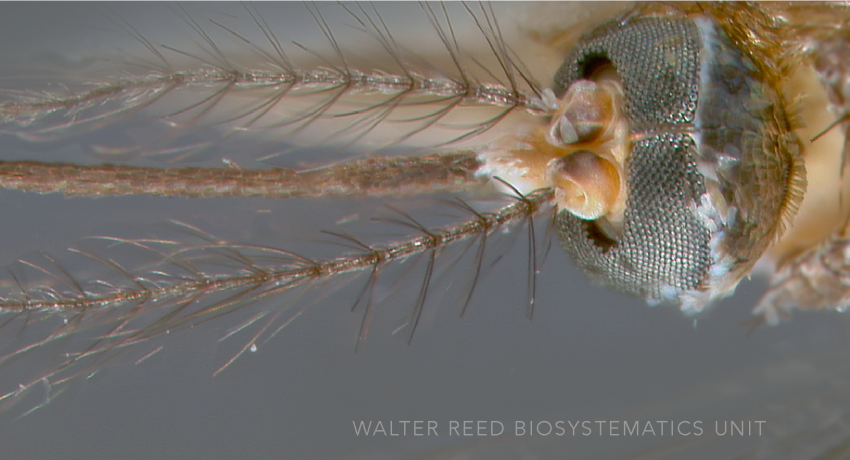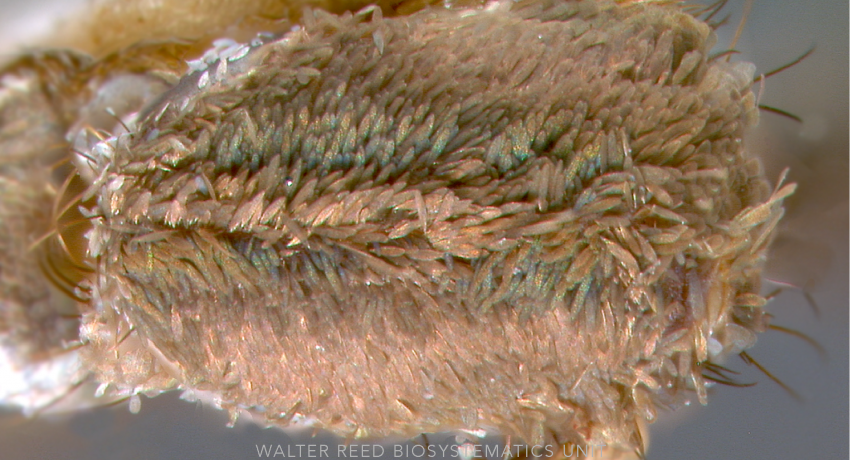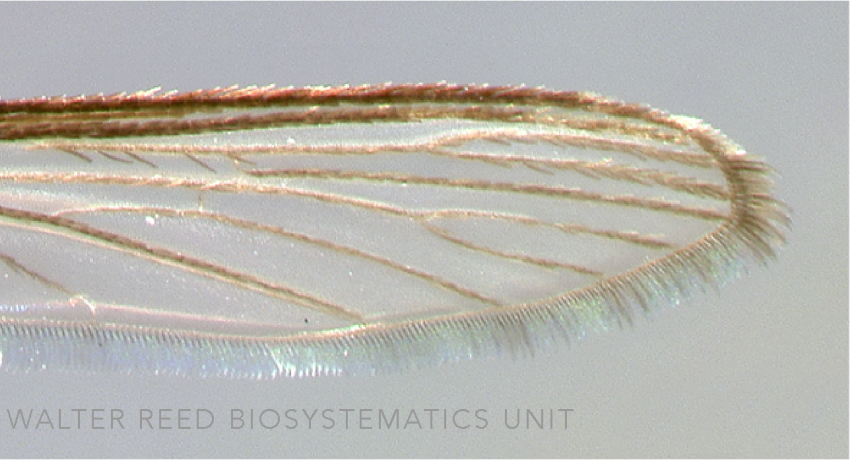AUSTRALASIAN, ORIENTAL & PALEARCTIC REGIONS
Generic abbreviation: Tr.
Type species: Runchomyia philippinensis Giles
Etymology: “tri-, L. (Gr. treis, trion) three; ptero-, pteron, Gr. feather, wing; -eides, Gr. (L. -aides) like, resembling, having the form of” (Harbach 2018c).
The genus Tripteroides is a large, complex assemblage of 122 species, subdivided into five subgenera - Polylepidomyia (19 species), Rachionotomyia (14 species), Rachisoura (28 species), Tricholeptomyia (9 species) and Tripteroides (52 species). Species are distributed from India to Japan, and south to Australia including the islands of southeast Asia and the South Pacific. The species comprising the genus are highly diverse, and the relationships among Tripteroides and Trichoproposon species remain unresolved as many characters overlap. The taxonomic status of this genus urgently needs revision.
DIAGNOSTIC CHARACTERS (Click photos to view; mouse over and click large photo to zoom in.)
ADULT (illustrated): Head: Erect head scales restricted to occiput. Thorax: Acrostichal setae absent; prespiracular setae present. Wing: Vein 1A terminates beyond level of the mediocubital crossvein; upper calypter with marginal setae.
LARVA (not illustrated): Head: Seta 3-C ventral; occipital foramen circular, with a distinct collar. Thorax: Seta 13-P present; seta 6-M and/or seta 7-T often as a stout spine. Terminal segments: Comb with comb scales in a single row; one multi-branched seta 4-X.
TAXONOMIC KEYS
Barraud 1934 (south Asia)
Lee 1946: 219 (Australasia)
Belkin 1950a: 201 (Solomon Islands)
Baisas & Ubaldo-Pagayon 1952 (Philippines)
Peters 1959: 135 (New Guinea)
Thurman 1959b (Thailand)
Belkin 1962 (South Pacific)
Peters 1963c: 89 (New Guinea)
Mattingly 1981 (Oriental Region; subg. Rachionotomyia & Tricholeptomyia)
Lee et al. 1989c (Australasia)
Rattanarithikul & Harrison et al. 2005 (Thailand)
Rattanarithikul et al. 2007 (Thailand)
![]()
WRBU – Genera – Global – Larva
![]()
WRBU – Genera – Australasia – Adult
![]()
WRBU – Genera – Australasia – Larva
![]()
WRBU – Genera – IndoMalaya – Adult
![]()
WRBU – Genera – IndoMalaya – Larva
![]()
WRBU – Genera – Oriental – Adult
![]()
WRBU – Genera – Oriental – Larva
![]()
WRBU – Genera – Eastern Palearctic – Adult
![]()
WRBU – Genera – Eastern Palearctic – Larva
Exemplar DNA sequences
Tp. affinis COI: EU259298
Tp. aranoides COI: AY917210
Tp. atripes COI: KU495085–86; KU495088
Tp. bambusa COI: KT358398–40; LC054517–21; EF647970
Tp. tasmaniensis COI: KU495089
All Tripteroides DNA sequences
BIONOMICS
Immatures
Tripteroides larvae rest upside-down on the substrate of the container, looking up through the water in search of food. While most species feed on detritus, the larvae of the subgenus Rachisoura posess enlarged, spiny maxillae and are predacious. In jungle-dependent species, Tripteroides immatures are common in the water collections in standing, fallen and discarded phytotelma habitats—bamboo and tree stumps, leaf axils (Allocasia, Colocasia, Nipa, Pandanus), ginger flower bracts, tree holes, snail shells, coconut shells and husks, Nepethes pitcher plants and fallen leaves. Immatures of the Australian endemic Tp. tasmaniensis (Strickland) solely inhabit rock holes and others, e.g., Tp. aranoides (Theobald), are collected in artificial containers.
Adults
Little is known of the biting preferences of most Tripteroides species. In the Australian Region, several species (e.g., Tp. solomonis Edwards) are strongly anthropophilic, entering houses to bite, whereas in the Oriental region, only Tp. aranoides is known to attack people. In Tp. aranoides mating is initiated in flight, and copulation takes place on vertical surfaces. The first oogenesis is autogenous, but subsequent egg batches require a blood meal. Females oviposit on the wing, with females flicking their abdomens and thrusting individual eggs into the larval habitats. Tripteroides bambusa (Yamada) are susceptible to infection with Getah virus.
*Associated pathogens: This list reports bacteria, viruses, and parasites recovered from, or experimentally passed through this species, and does not imply field vector status.
IMPORTANT REFERENCES (full citations below)
Giles 1904a: 369 (as genus, subgenus)
Barraud 1934 (taxonomic keys, bionomics; south Asia)
Lee 1946: 219 (taxonomic keys; Australasia)
Belkin 1950a: 201 (keys; Solomon Islands)
Baisas & Ubaldo-Pagayon 1952 (keys; Philippines)
Peters 1959: 135 (keys; New Guinea)
Thurman 1959b (taxonomic keys, bionomics; Thailand)
Belkin 1962 (taxonomic keys, bionomics; South Pacific)
Peters 1963c: 89 (P key; New Guinea)
Tanaka et al. 1979 (taxonomic bionomics; Japan)
Mattingly 1980 (classification)
Mattingly 1981 (taxonomic keys, bionomics; Oriental Region; subg. Rachionotomyia & Tricholeptomyia)
Lee et al. 1989c (taxonomic key, bionomics; Australasia)
Harbach & Peyton 1993 (L mouthparts; phylogeny)
Judd 1996 (phylogeny)
Rattanarithikul & Harrison et al. 2005 (F, L; taxonomic keys, bionomics; Thailand)
Rattanarithikul et al. 2007 (taxonomic keys, bionomics; Thailand)
VALID SUBGENERA
Polylepidomyia Theobald [Pol.]
Rachionotomyia Theobald [Rah.]
Rachisoura Theobald [Rac.]
Tricholeptomyia Dyar & Shannon [Tri.]
Tripteroides Giles [Trp.]
CURRENT SYNONYMS
Polylepidomyia
syn. Mimeteomyia Theobald 1910c: 210 (as genus). Type species: Mimeteomyia apicotriangulata Theobald.
Rachionotomyia
syn. Skeiromyia Leicester 1908: 248 (as genus). Type species: Skeiromyia fusea Leicester.
syn. Squamomyia Theobald 1910a: 28 (as genus). Type species: Squamomyia inornata Theobald.
syn. Mimeteomyia Theobald 1910c: 210. Type species: Mimeteomyia apicotriangulata Theobald.
Tripteroides
syn. Colonemyia Leicester 1908: 233. Type species: Colonemyia caeruleocephala Leicester (in Brunetti 1914: 58).
CITED REFERENCES
Barraud, P. J. (1934). The fauna of British India, including Ceylon and Burma. Diptera. Vol. 5. Family Culicidae, tribes Megarhinini and Culicini (Vol. 5). London: Taylor and Francis.
Belkin, J.N. (1950a). Mosquitoes of the genus Tripteroides in the Solomon Islands. Proceedings of the United States National Museum, 100(3262), 201–274.
Belkin, J.N. (1962). The mosquitoes of the South Pacific (Diptera, Culicidae) (Vols. 1 &2). Berkeley, California: University of California Press.
Giles, G.M. (1904a). Notes on some collections of mosquitoes, & c., received from the Philippine Islands and Angola; with some incidental remarks upon classification. Journal of Tropical Medicine, 7, 365–369.
Harbach, R.E., & Peyton, E.L. (1993). Morphology and evolution of the larval maxilla and its importance in the classification of the Sabethini (Diptera: Culicidae). Mosquito Systematics, 25(1), 1–16.
Judd, D.J. (1996). Review of the systematics and phylogenetic relationships of the Sabethini (Diptera: Culicidae). Systematic Entomology, 21(2), 129–150.
Lee, D.J. (1946). Notes on Australian mosquitoes (Diptera, Culicidae). Part VI. The genus Tripteroides in the Australasian Region. Proceedings of the Linnean Society of New South Wales, 70, 219–275.
Lee, D.J., Hicks, M.M., Griffiths, M., Debenham, M.L., Marks, E.N., Bryan, J.H., & Russell, R.C. (1989c). The Culicidae of the Australasian region. Volume 11. Commonwealth Department of Health, School of Public Health and Tropical Medicine Monograph Series, 2.
Leicester, G.F. (1908). The Culicidae of Malaya. Studies from the Institute for Medical Research, Federated Malay States, 3(3), 18–261.
Mattingly, P.F. (1980). An interim reclassification of the genus Tripteroides with particular reference to the Australasian subgenera. Mosquito Systematics, 12(2), 164–171.
Mattingly, P.F. (1981). Medical entomology studies - XIV. The subgenera Rachionotomyia, Trichoteptomyia and Tripteroides (Mabinii Group) of genus Tripteroides in the Oriental region (Diptera: Culicidae). Contributions of the American Entomological Institute, 17(5), 1–147.
Peters, W. (1959). Mosquitoes of New Guinea (Diptera: Culicidae). II. Notes on Tripteroides Giles, 1904. Proceedings of the Royal Entomological Society (B), 28, 135–154.
Peters, W. (1963c). Mosquitoes of New Guinea (Diptera: Culicidae) VI. The genus Tripteroides Giles: A new species of the subgenus Polylepidomyia Theobald, notes on the taxonomy and distribution and a revised key to described pupae. Proceedings of the Royal Entomological Society (B), 32, 89–100.
Rattanarithikul, R., Harrison, B.A., Panthusiri, P., & Coleman, R.E. (2005). Illustrated keys to the mosquitoes of Thailand. I. Background; geographic distribution; lists of genera, subgenera, and species; and a key to the genera. Southeast Asian Journal of Tropical Medicine and Public Health, 36(1), 1–80.
Rattanarithikul, R., Harbach, R.E., Harrison, B.A., Panthusiri, P., & Coleman, R.E. (2007). Illustrated keys to the mosquitoes of Thailand. V. Genera Orthopodomyia, Kimia, Malay, Topomyia, Tripteroides, and Toxorhynchites. Southeast Asian Journal of Tropical Medicine and Public Health, 38 (Supplement 2), 1–65.
Tanaka, K., Mizusawa, K., & Saugstad, E.S. (1979). A revision of the adult and larval mosquitoes of Japan (including the Ryukyu Archipelago and Ogasawara Islands) and Korea (Diptera: Culicidae). Contributions of the American Entomological Institute, 16, 1–987.
Theobald, F.V. (1910a). Second report on the collection of Culicidae in the Indian Museum, Calcutta, with descriptions of new genera and species. Records of the Indian Museum, 4, 1–33.
Theobald, F.V. (1910c). A monograph of the Culicidae of the World (Vol. V). London.
Thurman, E.B. (1959b). A contribution to a revision of the Culicidae of northern Thailand. Bulletin of the University of Maryland Agriculture Experimental Station A, 100, 1–177.
CITE THIS PAGE
Walter Reed Biosystematics Unit (Year). Tripteroides genus page. Walter Reed Biosystematics Unit Website, http://wrbu.si.edu/vectorspecies/genera/tripteroides, accessed on [date (e.g. 03 February 2020) when you last viewed the site].






